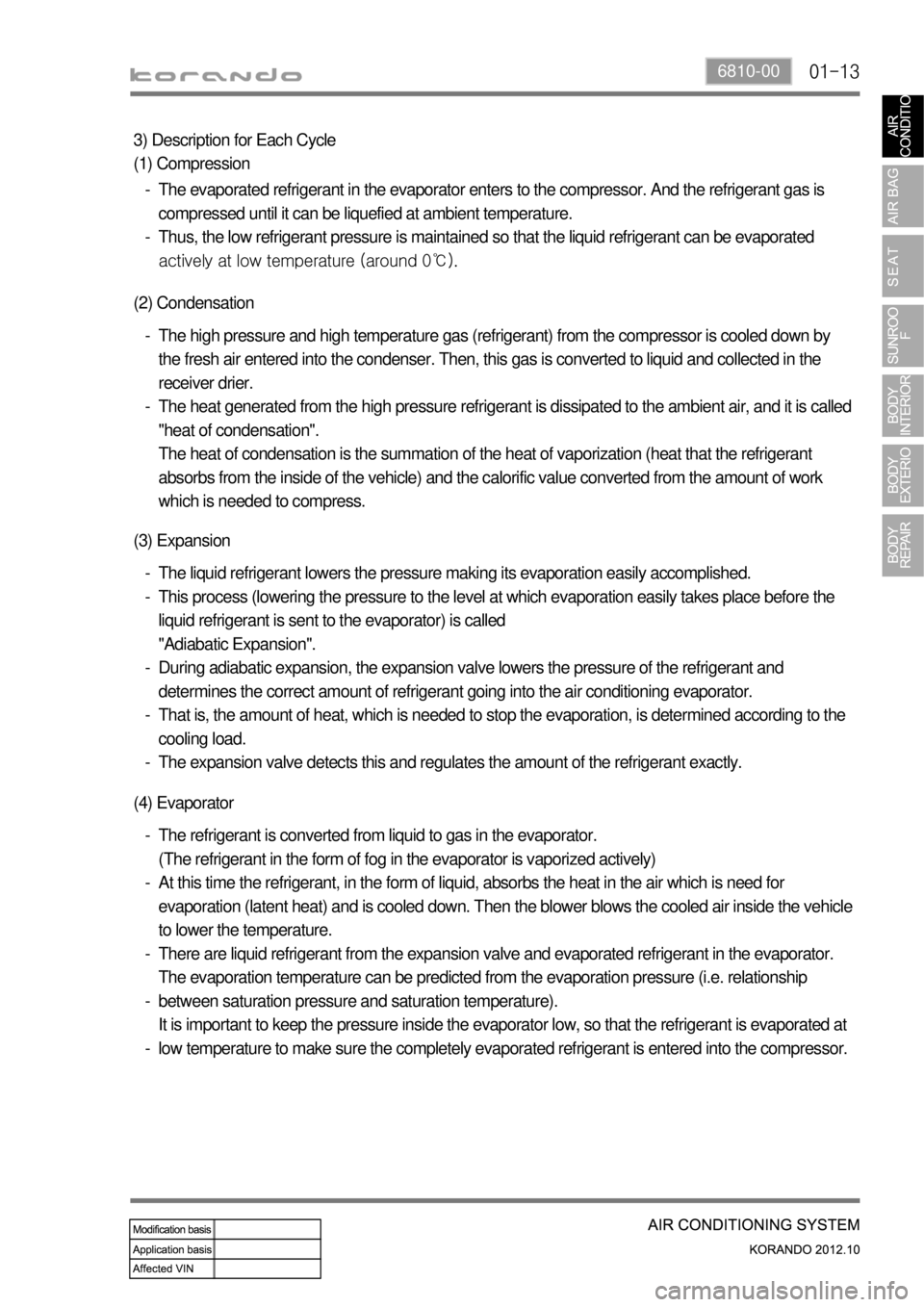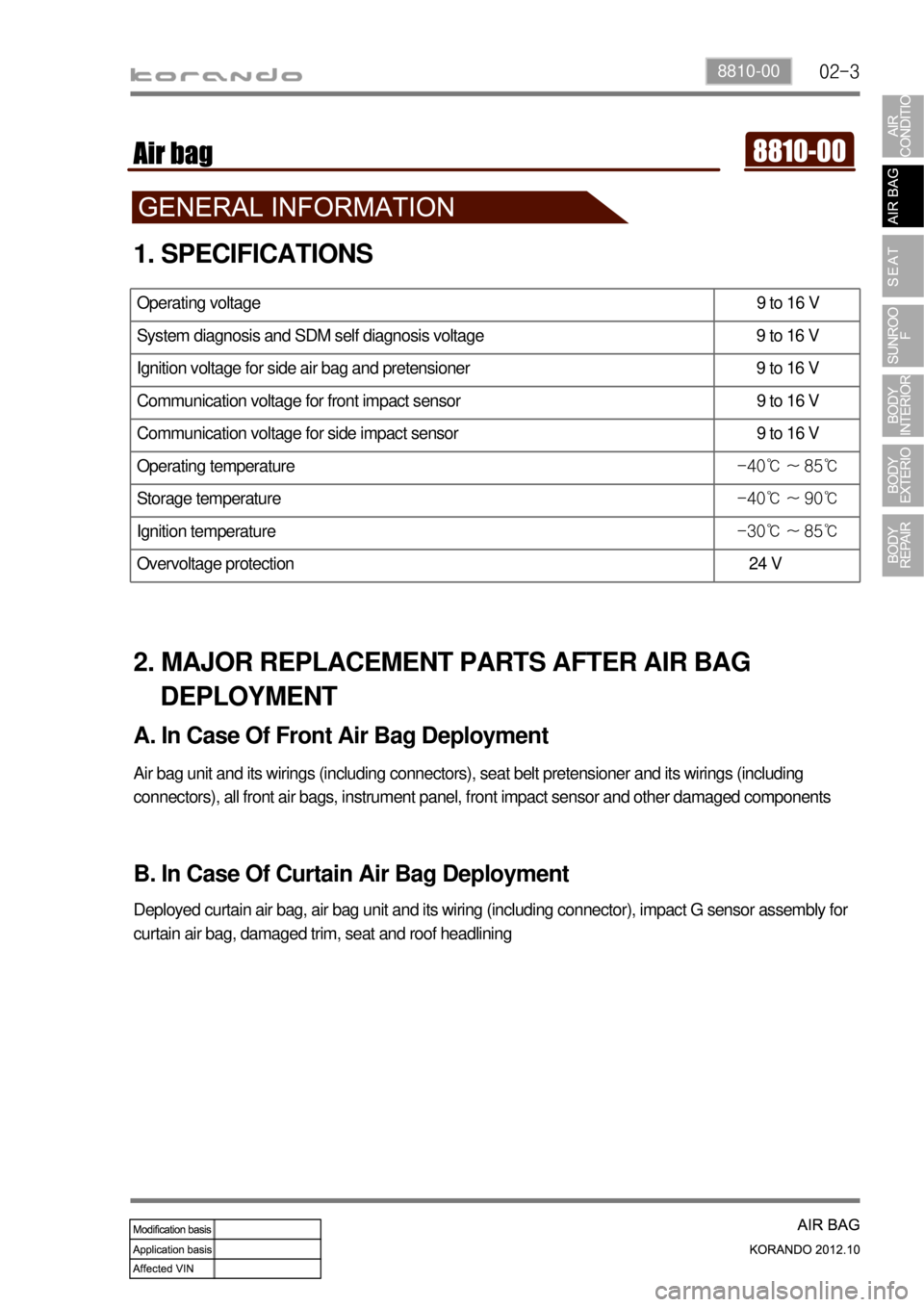SSANGYONG KORANDO 2012 Service Manual
KORANDO 2012
SSANGYONG
SSANGYONG
https://www.carmanualsonline.info/img/67/57504/w960_57504-0.png
SSANGYONG KORANDO 2012 Service Manual
Trending: rear view mirror, steering, winter tires, gas type, airbag, USB, manual transmission
Page 1011 of 1082
01-10
Recirculation switchTemperature dial Mode dial Fan speed dial
A/C switch
2) Manual A/C Control
Fan speed dial
The fan speed can be adjusted
by rotating the switch. To stop
the operation, turn the dial to the
"OFF" position.
The level is adjustable in 7
steps. A/C switch
When pressing the switch with
the engine running, the A/C
compressor operates and the
indicator comes on. Pressing
the switch again deactivates the
compressor and turns off the
indicator.
Fan speed dial ▶
Page 1012 of 1082
01-116810-00
Face/Foot-Level
(bi-level mode)
Face-Level (vent mode)Foot-Level (foot mode)
Use this switch to remove fog or ice from
the windshield.
When pressing this switch, the airflow
direction will be changed to windshield
and door glasses, the A/C is operated
automatically and the air source mode is
set to fresh air mode. Defrost mode
Temperature dial ▶Mode dial ▶
Recirculation switch
When pressing this switch, the air is
recirculated in the vehicle and the
indicator on the switch comes on.
When pressing it again, the indicato
r
goes off and the fresh air comes in.
When it's rainy or humid, set this
switch to fresh air mode with the
defroster mode selected to clear the
fogged windshield.Foot/Defrost-level
(Foot & defrost mode)
Temperature dial
Rotate this dial to adjust the
temperature.
Turning this switch clockwise
(red side) increases the
temperature and
counterclockwise (blue side)
decreases the temperature.
Page 1013 of 1082
01-12
3. A/C COOLING CYCLE
1) System flow
Condition: Gas/Liquid
Function: Keeps the refrigerant free from moisture by separating/collecting the moisture from it. -
-"Compression -> Condensation -> Expansion -> Evaporation" -
Condition: Liquefied gas/Gas
Function: Cools the air by absorbing the heat from the air around the evaporator. -
-Condition: Liquid/Liquefied gas
Function: Performs adiabatic expansion and flow control for easier evaporation. -
-Condition: Gas/Liquid
Function: Cools and condenses the refrigerant by using ambient air to liquefy it under high pressure. -
-Condition: Gas
Function: Circulates the refrigerant and increases the pressure and temperature for easier
evaporation. -
- 2) Functions
(2) Condenser
(3) Receiver drier
(4) Expansion valve
(5) Evaporator
(1) Compressor
Page 1014 of 1082

01-136810-00
The refrigerant is converted from liquid to gas in the evaporator.
(The refrigerant in the form of fog in the evaporator is vaporized actively)
At this time the refrigerant, in the form of liquid, absorbs the heat in the air which is need for
evaporation (latent heat) and is cooled down. Then the blower blows the cooled air inside the vehicle
to lower the temperature.
There are liquid refrigerant from the expansion valve and evaporated refrigerant in the evaporator.
The evaporation temperature can be predicted from the evaporation pressure (i.e. relationship
between saturation pressure and saturation temperature).
It is important to keep the pressure inside the evaporator low, so that the refrigerant is evaporated at
low temperature to make sure the completely evaporated refrigerant is entered into the compressor. -
-
-
-
- (4) Evaporator (3) Expansion (2) Condensation
The liquid refrigerant lowers the pressure making its evaporation easily accomplished.
This process (lowering the pressure to the level at which evaporation easily takes place before the
liquid refrigerant is sent to the evaporator) is called
"Adiabatic Expansion".
During adiabatic expansion, the expansion valve lowers the pressure of the refrigerant and
determines the correct amount of refrigerant going into the air conditioning evaporator.
That is, the amount of heat, which is needed to stop the evaporation, is determined according to the
cooling load.
The expansion valve detects this and regulates the amount of the refrigerant exactly. -
-
-
-
-The high pressure and high temperature gas (refrigerant) from the compressor is cooled down by
the fresh air entered into the condenser. Then, this gas is converted to liquid and collected in the
receiver drier.
The heat generated from the high pressure refrigerant is dissipated to the ambient air, and it is called
"heat of condensation".
The heat of condensation is the summation of the heat of vaporization (heat that the refrigerant
absorbs from the inside of the vehicle) and the calorific value converted from the amount of work
which is needed to compress. -
- 3) Description for Each Cycle
(1) Compression
The evaporated refrigerant in the evaporator enters to the compressor. And the refrigerant gas is
compressed until it can be liquefied at ambient temperature.
Thus, the low refrigerant pressure is maintained so that the liquid refrigerant can be evaporated
actively at low temperature (around 0℃). -
-
Page 1015 of 1082
01-14
4. A/C COOLING CIRCUIT
Page 1016 of 1082
Page 1017 of 1082
Page 1018 of 1082
Page 1019 of 1082
02-38810-00
1. SPECIFICATIONS
Operating voltage 9 to 16 V
System diagnosis and SDM self diagnosis voltage 9 to 16 V
Ignition voltage for side air bag and pretensioner 9 to 16 V
Communication voltage for front impact sensor 9 to 16 V
Communication voltage for side impact sensor 9 to 16 V
Operating temperature -40℃ ~ 85℃
Storage temperature -40℃ ~ 90℃
Ignition temperature -30℃ ~ 85℃
Overvoltage protection 24 V
2. MAJOR REPLACEMENT PARTS AFTER AIR BAG
DEPLOYMENT
A. In Case Of Front Air Bag Deployment
Air bag unit and its wirings (including connectors), seat belt pretensioner and its wirings (including
connectors), all front air bags, instrument panel, front impact sensor and other damaged components
B. In Case Of Curtain Air Bag Deployment
Deployed curtain air bag, air bag unit and its wiring (including connector), impact G sensor assembly for
curtain air bag, damaged trim, seat and roof headlining
Page 1020 of 1082

02-4
3. OPERATING CONDITIONS
A. Front Air Bag System
The air bag does not deploy when: ▶The air bag deploys when: ▶
The air bag can deploy when: ▶A front collision occurs, which occupants cannot be protected by seat belt. -
The vehicle rolls over or tips over sideward, or a side/rear collision occurs.
the impact of the collision is low enough for the seat belt to protect the occupant properly. -
-Underbody impact from the road surface, impact against the curb at a very high speed, or
dropping impact onto the road surface with a large angle occurs. -
Seldom oeprate ▶
A collision to diagonal direction (not a front collision) occurs or the vehicle tips over.
A weak collision, which the sensor cannot detect, occurs (under the activation requirements).
A collision against narrow objects such as a telegraph pole or a tree occurs.
The vehicle falls into a drainage or a puddle.
The front of the vehicle crashes into high impact point vehicle such as a truck.
The hood is hit by falling stones.
The air bag warning lamp is on. -
-
-
-
-
-
-
Trending: Check engine light, wheel torque, Air conditioning, wiring, brake light, service interval, engine coolant









